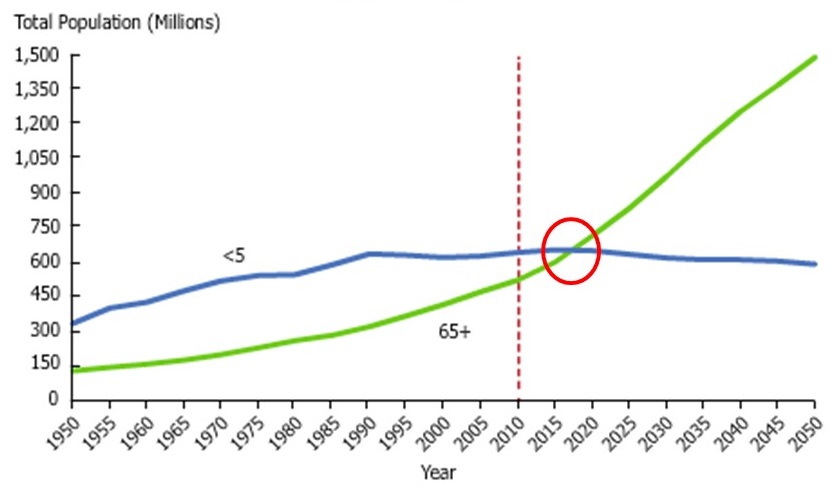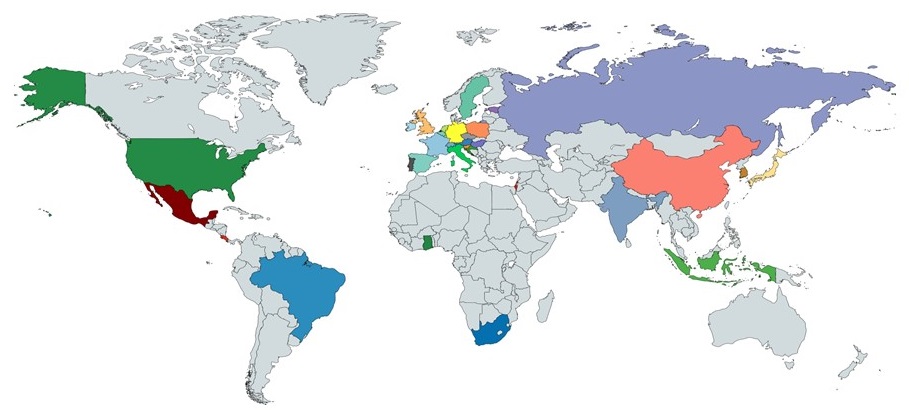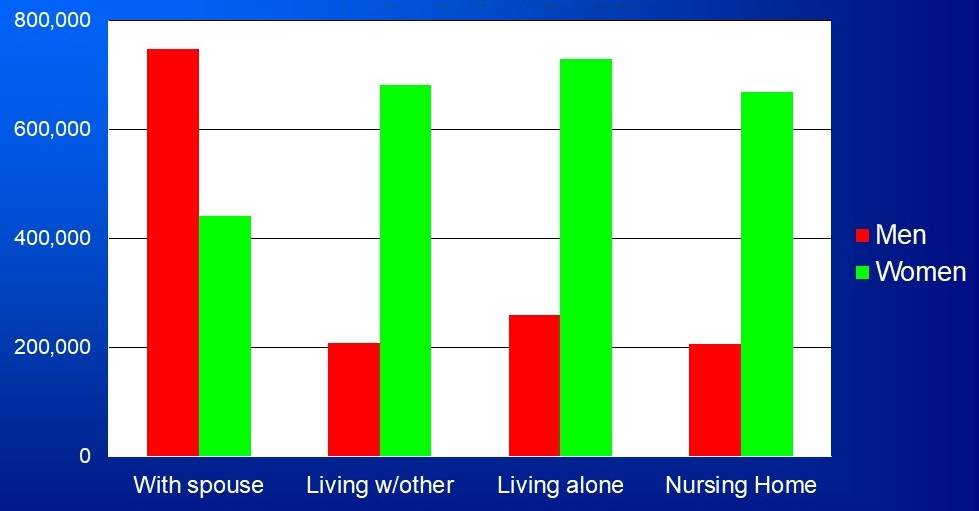Monday, January 27, 2020
Printer Friendly Version in PDF Format (13 PDF pages)
Tracking the Burden of Alzheimer's Disease and Dementia in the United States: The Health and Retirement Study (HRS)
Kenneth M. Langa, MD, PhD
Division of General Medicine
Institute for Social Research
Ann Arbor VA Health System
Institute for Healthcare Policy and Innovation
Institute of Gerontology
University of Michigan
No Financial Conflicts of Interest
Overview
- Definitions and Background
- Tracking the Burden of Alzheimer's Disease and Dementia in the US with the Health and Retirement Study (HRS)
- Trends in Dementia Incidence / Prevalence
Definitions and Background
Definitions: Epidemiology of Dementia
- Prevalence Rate
- The proportion of individuals in a defined population with the disease / condition
- Incidence Rate
- Number of new cases of disease in a defined population during a specified time interval
- Prevalence is a function of the incidence rate, and life expectancy with the disease
- The number of cases of disease can increase, even if the incidence / prevalence rate declines
- "Age-specific" individual risk vs. Total cases in population
Complexities in Dementia Epidemiology
- Identifying the "Dementia Threshold"
- Typically a slowly progressive condition, so difficult to define time of onset of "impairment of usual activities"
- Methodological Challenges
- Need for proxy respondents
- Institutional populations
- Population-based vs. Clinic-based samples?
- International Comparisons
- Differences in language, education, social structures complicate comparisons of testing and definitions of "disability"
- Differences in life-expectancy may lead to different populations at risk across countries
Demographic Imperative
| World Population, Age 65+ and Age <5 |
|---|
 |
| SOURCE: Population Reference Bureau |
Tracking AD and Dementia using the Health and Retirement Study (HRS)
Health and Retirement Study (HRS)
- Ongoing, nationally representative, longitudinal, biennial survey of ∼ 20,000 Americans aged > 50
- Performed at the UM Institute for Social Research, funded by the NIA and SSA (PI: David Weir)
- Data collection started in 1992
- Extensive data on health, cognition, economics, work, and family from a national sample
- Face-to-face and telephone interviews (50 / 50)
- > 4,000 HRS publications by > 2,000 authors; >20,000 registered data users
Source: Sonnega et al, International J of Epidemiology, 2014.
HRS Survey Content
- Demographic characteristics
- Physical and functional health
- Performance-based cognitive testing
- Family structure and transfers
- Employment status, job history, and disability
- Retirement plans and perspectives
- Assets, income, and net worth
- Housing and services use
- Health insurance and pension plans
- Out-of-pocket health costs
- Links to data from employers, Medicare, NDI, VA, and SSA
- Biomarkers (2006)
- Cholesterol, HgbA1c, CRP, Cystatin C, BP, Pulse, Peak flow, Balance, Gait
- Venous Blood in 2016
- Genetics (2012)
- 2.5 M SNPs on 20,000 people
HRS International Partner Studies Around the World
 |
| Harmonization tool at USC Gateway to Global Aging https://g2aging.org/ |
Tracking Brain Health in the HRS
- Modified Telephone Interview for Cognitive Status
- orientation to day, date, month, year
- immediate and delayed recall of 10 nouns
- serial 7 subtraction
- counting backwards
- object naming
- naming of the president and vice-president
- Verbal fluency
- Number Series
- Numeracy questions
- Speed of processing
- Self report of:
- Memory function; ADL / IADL limitations; prior diagnosis of AD or dementia; medications for AD or dementia
- Protective and risk factors for brain health
- CV disease risks (measured BP, obesity, health behaviors)
- Acute medical events (stroke, sepsis, CABG => Medicare)
- Genetics (ApoE, 2.5 million SNPs)
- Education and leisure time activities (reading, puzzles, etc.)
- Employment history, wealth
- Social ties and extent of social interactions
- Early-life factors (childhood health, parents' education)
- Respondents represented by proxy:
- IQCODE
- Memory function, judgment, and change over the last 2 years
- Doctor diagnosed AD or dementia
- ADL / IADL limitations
- "Exit" Interview for those who have died
Aging, Demographics, and Memory Study (ADAMS)
- Supplemental study to the HRS funded by the NIA
- First US national, population-based study of dementia to include subjects from all regions of the country
- Initial field period: 2001 - 2005, follow-up through 2010
- 856 HRS subjects, evaluated in their homes
- 3-4 hour neuropsychological assessment, neuro exam, informant interview, ApoE genotype
- Consensus panel diagnosis of CIND or dementia, with differential diagnosis of cause (AD, Vascular, Other)
Source: Langa et al, Neuroepidemiology, 2005..
Defining Dementia in the HRS
- Equipercentile Equating
- Define cut-points on HRS cognitive (and other) measures that result in similar dementia prevalence estimates as the "gold-standard" ADAMS estimates
- Regression-based Algorithms
- Multivariable models derived from relevant HRS cognitive, health, and sociodemographic measures that provide probability of dementia for each respondent
- Wu - Glymour, 2012; Hurd et al, 2013; Cleret de Langavant - Yaffe 2018; Gianattasio et al, 2019 and 2020
- Accuracy > 90% with most models; important to consider differing accuracy across race / ethnicity (Gianattasio papers)
Sources: Langa et al, Alz Assoc, 2009; Crimmins et al, J. of Geron, 2011; Wu et al, ADAD, 2012; Hurd et al, NEJM, 2013; Cleret de Langavant et al, Med Int Res, 2018; Gianattasio et al, Epid, 2019, 2020.
HRS-ADAMS Estimates of 2012 US Population Prevalence, Age 65+
 |
| SOURCE: Plassman, et al, Neuroepidemiology, 2007; Annals of Internal Medicine, 2008; Langa et al, JAMA IM, 2017. |
Dementia and the Family
| Informal Caregiving Time and Cost, USA |
|---|
 |
| SOURCE: Langa et al, 2000 - 2004. |
Living Arrangements of US Adults 65+ with Dementia
 |
| SOURCE: Langa, Kabeto, Weir, HRS 2012, unpublished data. |
Dementia Annual Cost Per Case United States, 2010
 |
| SOURCE: Hurd et al, NEJM, 2013. |
HRS: Dementia Prevalence Rate, Age 65+
 |
| SOURCE: Langa et al, JAMA Internal Medicine, 2017.. |
Studies of Population Trends
- Declining Age-Specific Prevalence / Incidence of Dementia:
- US NLTCS (Manton et al, 2005)
- US HRS (Langa et al, 2008, 2017; Hudomiet et al. 2018)
- UK CFAS / ELSA (Llewellyn and Matthews, 2009)
- US Mayo Clinic Study on Aging (Rocca, 2011)
- Rotterdam Study (Schrivjers et al, 2012)
- Swedish Kungsholmen Project (Qiu et al, 2013)
- Danish Cohorts Study (Christensen et al, 2013)
- UK Cognitive Function and Ageing Study (Matthews et al, 2013, 2016)
- US MoVIES Cohort (Dodge et al, 2014, 2016)
- US Framingham Heart Study (Satizabal et al, 2016)
- Indianapolis-Ibadan Project (Gao et al, 2016; Hendrie et al, 2018)
- US NLTCS (Stallard and Yashin, 2016)
- US Americans' Changing Lives Study (Leggett et al, 2017)
- US Einstein Aging Study (Derby et al, 2017)
- US NHATS (Freedman et al, 2018)
Recent Studies Suggesting Declining Age-Specific Dementia Risk
| Selected Recent Studies of the Dementia Epidemic. | ||||
|---|---|---|---|---|
| Study | Outcome | Data Source | Key Findings | Factors |
| Manton et al. (United States)[1] | Prevalence of severe cognitive impairment | National long-term care survey interviews, 1982-1999 | Decline in dementia prevalence among people >65 yr of age (5.7% to 2.9%) | Higher educational level, decline in stroke incidence |
| Langa et al. (United States)[2] | Prevalence of cnogitive impairment | Ongoing population-based survey of people >51 yr of age | Prevalence of cognitive impairment among people >70 yr of age (12.2% in 1993 vs. 8.7% in 2002) | Higher educational level; combination of medical, lifestyle, demographic, and social factors |
| Schrijvers et al. (Rotterdam)[3] | Incidence of dementia | Population-based cohort >55 yr of age in 1990, extended in 2000 | Incidence rate ratios (6.56 per 1000 person-yr in 1990 vs. 4.92 per 1000 person-yr in 2000) | Higher educational level, reduction in vascular risk, decline in stroke incidence |
| Qiu et al. (Stockholm)[4] | Prevalence of DSM-III-R dementia* | Cross-sectional survey of people >75 yr of age, 1987-1989 and 2001-2004 | Age- and sex-standardized dementia prevalence (17.5% in 1987-1989 vs. 17.9% in 2001-2004); lower hazard ratio for death in later cohort suggests decreased dementia incidence | Favorable changes in risk factors, especially vascular risk; healthier lifestyles |
| Matthews et al. (England)[5]† | Prevalence of dementia in 3 regions | Survey interviews of people >65 yr of age, 1989-1994 (in CFAS I) and 2008-2011 (in CFAS II) | Dementia prevalence (8.3% in CFAS I vs. 6.5% in CFAS II) | Higher educational level, better prevention of vascular disease |
| SOURCE: Larson, Yaffe, and Langa, NEJM, 2013. | ||||
Harmonized Cognitive Assessment Protocol (HCAP)
- New HRS sub-study of dementia funded by the NIA
- One-hour of cognitive testing and 20-minute informant interview in sub-sample (N∼3,500) of HRS respondents
- Will produce a replicable algorithmic diagnosis for use in HCAP sub-samples and the full samples of a number of the HRS international family of studies
- Creates a public data resource to track dementia burden in high- and low-income countries around the world
Source: Langa et al, Neuroepidemiology, 2019..
Conclusions
- Nationally-representative population-based studies are important resources for tracking the epidemiology of dementia as populations age around the world
- Rising levels of education and better control of cardiovascular risk factors may have contributed over the last few decades to a decline in age-specific dementia risk in older adults in high-income countries
- Primary prevention of dementia through social and behavioral interventions appears possible and valuable
HRS / ADAMS / HCAP Funding
- National Institute on Aging
- Social Security Administration
